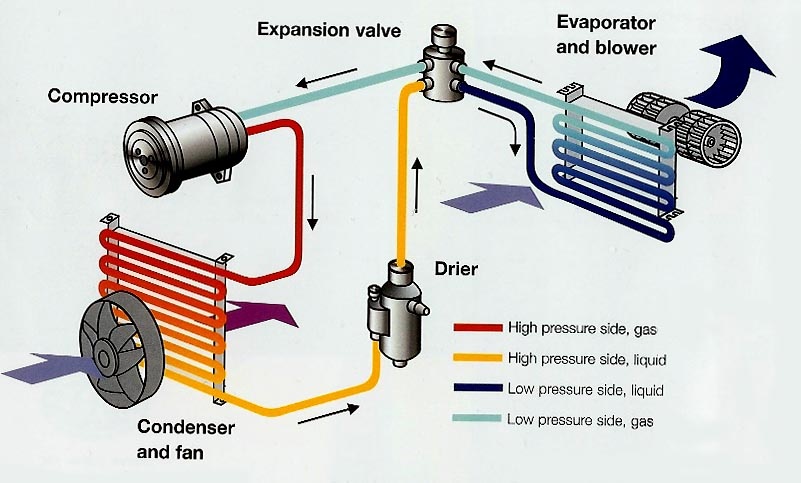Air conditioning systems are first appeared in luxury automobiles in the early 1940’s. Today almost all cars, including small family hatch backs come with air conditioning as standard. With just push on a button or the slide of a lever, we get the ultimate chill we desperately long for blasting out of our vents to survive the hot concrete jungle. However, most of us take this for granted. Yet, your vehicle’s air conditioning system does not create cold air like you may think. In reality, it helps remove the heat and humidity from inside the passenger compartment of the vehicle, leaving behind cooler air. There are four basic functions an air conditioning system involves- temperature control, air circulation control, and humidity control and air purification. An air conditioner uses the refrigerant absorbing heat as it evaporates. Our air conditioning system goes by four principles to fulfill it. They are compression, expansion, evaporation and condensation. The words themselves can clearly tell us what they direct to. Our air conditioning system has specific components to employ the above physical processes in order to achieve the goal it is designed for. It also benefits the driver’s visibility by reducing the moisture in the air that can form on the inside of the car windows. The respective components are compressor, condenser, receiver or dryer, expansion valve and evaporator. Compressor plays an important role in air conditioning system. It pumps refrigerant vapor to the condenser under extremely high pressure. The condenser is used to change the heated high pressure refrigerant gas to liquid. In the process, the heat is taken into the atmosphere by the air flowing through the condenser. Then the now liquid refrigerant moves to the receiver-dryer, where any moisture that may have leaked into the refrigerant is captured. Because ice crystals formed in the circulating process can cause blockages and mechanical damage. The pressurized refrigerant next flows to the expansion valve. The valve removes pressure from the liquid and it expands and reverts back to rapid cooling vapor. Here the highly cooled refrigerant vaporizes and absorbs heat from the air in the passenger compartment. Basically, there are two types of cooling systems found on motor vehicles, liquid cooled and air cooled. This is easy to understand. Furthermore, based on the type of device that is used to lower the refrigerant pressure, air conditioning systems used in the present automobile industry can be classified into two main types, expansion valve system and fixed orifice tube system. The orifice tube systems are commonly found in General Motors (GM) and Ford models while the expansion valve system is generally used on after-market systems.
If your auto air conditioning isn’t working properly, and you are inclined to find the problem yourself.You may be interested in some of the professinal diagnostic tools we offered on our website. AllScanner VCX-PLUS is such a tool appropriate for you.It is the latest professinal tester for Porsche, also LandRover and Jaguar after 2005 year with support of JLR V139 sofetware.In addition to air conditioning, it also supports systems like engine, automatic transmission,SRS, ABS, ASR, MPL, GM, Original antitheft System, Keyless GO system and OBDII system.More to find by cliking the product image below.

What You Don’t Know About Your Automotive Air Conditioning System
by
Tags:
